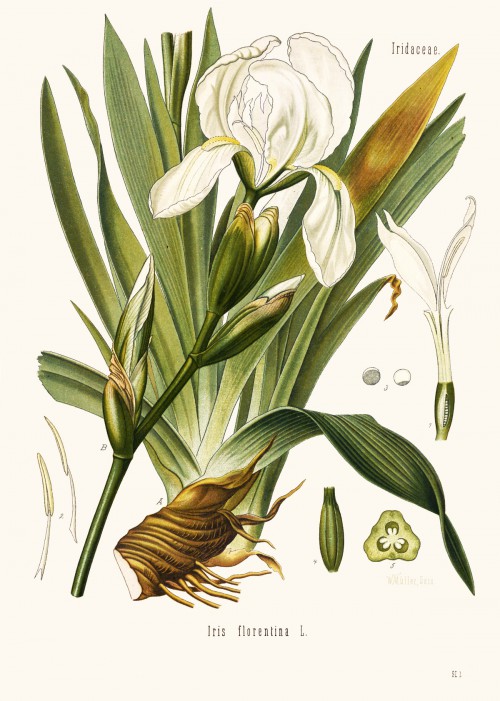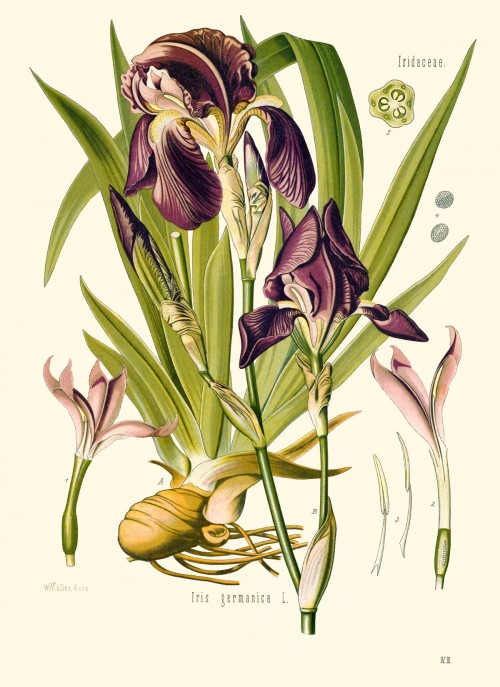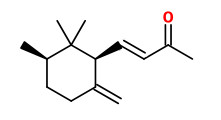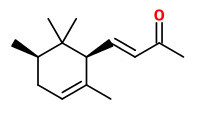Dies ist eine alte Version des Dokuments!
Iris germanica L. - Iridaceae - German iris, Deutsche Schwertlilie
Natural hybrid of European origin, 30-80cm high; rhizome usually many-branched, 1-2 cm diam. „Leaves equitant, blade sometimes purplish at base, ensiform, to 4.5 dm × 3.5 cm, glaucous. Inflorescences with terminal unit 2-3-flowered, branch units 1-2-flowered; spathes green, sometimes with purple base, 2-5 cm, herbaceous with narrow, scarious margins and tip. Flowers: perianth shades of blue-violet, yellow, brown, or white with various patterns of pigment distribution…“ http://www.efloras.org/florataxon.aspx?flora_id=1&taxon_id=200028171
Iris germanica root extract (orris butter of Iris germanica) is produced by steam distillation of the grounded and carefully dried (for 5 years at ambient temperature) rhizomes. The typical odor of the oil (violet, floral, woody) is attributed to the irones, which are structurally related to the ionones of violet oil.
Iris florentina L. (white flag, Florentine iris, Florentine orris, Florentiner Schwertlilie) is a synonym for Iris ×germanica L. nothovar. florentina Dykes. http://www.ars-grin.gov/cgi-bin/npgs/html/taxon.pl?400251
„The racemates of all irone isomers (cis-α, trans-α, β, cis-γ, trans-γ) have been resolved by chiral capillary gas chromatography and the separated pure enantiomers have been olfactorily characterized by using GC-sniffing techniques. (+)-cis-γ-Irone and (+)-cis-α-irone were found to have the most interesting organoleptic properties.“
(+)-Cis-γ-irone (61.3%), (+)-cis-α-irone (34.5%), (+)-trans-α-irone (4.2%) and β-irone (0.16%) were found as the major components of industrially-produced orris oil of I.germanica.
[Direct enantioselective separation and olfactory evaluation of all irone isomers., Galfré, A., Martin, P., Petrzilka, M., Journal of Essential Oil Research, 5(3), 1993, 265-277]
„The essential oil of Iris florentina was extracted by hydro distillation by using Clevenger apparatus, and resinoide and absolute were obtained by using n-hexane and ethyl alcohol, respectively. Essential oil components were identified by GC/MS (QP5050 gas chromatography/mass spectrometry). Statistically non-significant differences were observed in the fresh and dry rhizome, and statistically significant differences (p<0.01) in the resinoide and absolute of Iris florentina. In the Iris florentina, the fresh and dry rhizome essential oil resinoide were determined as 0.04% and 0.07% respectively, and the resinoide and absolute were obtained as 2.21% and 1.92%, respectively. The main compounds of Iris florentina essential oil, resinoide and absolute were determined as decanoic acid, ethanon, α-irone, trans-2,6-γ-irone, lauric acid, myristic acid, palmitic acid, 9,12-octadecadienoic acid and hexanedioic acid bis ester. In the main components of essential oil, resinoide and absolute of iris were significant differences determined. α-irone and γ-irone contents weren't determined in fresh rhizome essential oil that they are accepted as the most significant commercial quality criteria of iris essential oil. The highest α-irone and trans-2,6-γ-irone contents were obtained in dry rhizome essential oil (4.21% and 7.88%, respectively), their the lowest values were determined in resinoide (0.69% and 1.25%, respectively).“
[Scent components in essential oil, resinoids and absolute of iris (Iris florentina L.). Kara, N., Baydar, H., Anadolu Tarım Bilimleri Dergisi, Vol.29(1), 2014, 70-74]

Iris florentina, Köhler, F.E., Medizinal Pflanzen, vol.2 t.921 (1890)
http://plantgenera.org/species.php?id_species=558371

Iris germanica, Köhler, F.E., Medizinal Pflanzen, vol.2 t.923 (1890)
http://plantgenera.org/species.php?id_species=558371


